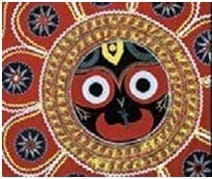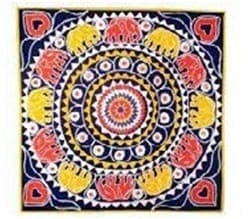
ABSTRACT
The famous appliqué work of Orissa originated from India as a temple craft. Today, its application is found in a wide range of products. The eye-catching colours, mythical motifs, distinctive stitches, and delicate embroideries come together to make it different from other appliqué work while adding an element of uniqueness.
The present paper aims to study the transcendental journey of Pipili from the original temple craft to the global market place. The first objective of this paper is to examine the evolution of this craft during Mughal and British era. Furthermore, the second objective is to study the factors that influenced the modernisation of this temple craft for universal global appeal. It was observed that the craft has steadily evolved over the years to adapt to changing times and taste of consumers. However, the core essence of appliqué work from Orissa has been retained and is almost always associated with the Jagannath culture.
India is a treasure trove of the world’s most exquisite handicrafts. Each part of India has a different craft. Orissa is one such state which has abundant of colourful art and crafts. One of them is the famous Pipili work, which is also known as ‘Chandua Kamo’. In the local language “Chandua” means appliqué and “Kamo” means work. It is currently one of the most attractive products within the world handicraft market. Appliqué is actually a French term, which is used to describe a decorative effect. This effect is usually obtained by superimposing patches of coloured fabric on a base fabric. The edges of the patches are then sewn with different types of stitches. This technique has been adopted in different parts of the world. Many other places in India also produce appliqué work. Regions within Guja-rat, Bihar, Orissa, Rajasthan, and Tanjore also produce distinct forms of appliqué work. In Orissa, Pipili, Puri produces vibrant appliqué work. [2]

As Pipili originated in India as a temple craft, the handcraft items were mainly used during procession of the deities in their various ritual outings. The traditional items included Chatti (umbrella), Tarsa (heart shaped banner), Canopy, and Jhalar (Frills). Even today it is used for a variety of rituals. Making seats and pillows, or ritual dresses for the presiding deities is a common activity. Earlier, only the Darji caste performed the religious seva. The Darjis also mended umbrellas or quilts. Gradually, after several generations, the practice of this unique craft became the most preferred profession of the Darjis.

Therefore, a craft which originated as a temple art in Orissa now finds its application in a wide range of household, decorative, apparel and ceremonial products. The main objective of this paper is to study the mystical journey of traditional Pipili art from temple craft to the contemporary global market. Further, another objective is to study the influence of Mughal and British era on Pipili craft and the resulting transformations.
DISCUSSION
Story behind the origin of Pipili craft
Culturally, Orissa is renowned for the temple of Lord Jagannath. As this holy land within Orissa boasts of fifty-two handicraft variations, Orissa is the home of traditional arts and craft. Among these, appliqué work is one of the famous and ancient crafts. The appliqué craft first originated within the Pipili village near Puri. The presence of appliqué craft is said to be closely linked with Jagannath temple tradition (Figure:1). This craft was initially confined to a suchikas caste which was known as Si-Pu-Ti. The folklore behind the origin of appliqué craft is often linked to a ruling monarch in the capital city of Delhi.
It is believed that the Badshah of Delhi had ordered a Si-Pu-Ti to prepare two pillows for him. After the pillows were produced for the Badshah, the artisan found it so beautiful that he thought of offering these pillows to Lord Jagannath as well. The artisan believed that such exotic and mystical objects should only be owned by the Lord of the Universe. One morning, when the artisan returned to perform his daily duties, one pillow was missing. The emperor immediately imprisoned the artisan, assuming that he had stolen the pillow. But in the Emperor’s dream, Lord Jagannath told him that the Si-Pu-Ti was innocent. The next day this craftsman was released.
After completion of his work, the artisan returned to Pipili and taught his specialised craft skills to the people of his caste. Later, the craft spread to other areas in Orissa. Meanwhile, the Gajpati king of Puri finally decided to incorporate Pipli craftwork into the paraphernalia associated with of Lord Jagannath. Thus, Pipili village was established by the king of Orissa for accommodating the craftsmen who made appliqué umbrellas and canopies for the annual Jagannath Yatra processions. Until then, the Si-Pu-Ti’s were engaged in only religious activities during the festive periods. During other times, they made quilts and mended umbrellas. [2]
Evolution of the craft in Mughal and British era
In 1621 A.D, Pipili was seized by Prince Khurram. This resulted in a huge settlement of the Muslim community in the locality. Later this newly settled community also started practising this craft. Thereafter, this applique craft became a harmonious product of the mixture of Hindu and Muslim craft traditions. Earlier the Pipli craft had been created by a technique where the decorative effect was obtained by superposing patches of coloured fabrics on a base fabric, while the edges of the patches are being sewn in some form of stitchery.
In the Mughal era however, the tone of the craft be- come more alluring. A contemporary approach was then added using accessories like sequins, minute mirrors, and laces. In course of time, the Islamic word Darji might have taken in with the Hindu caste suchika or Si-Pu-Ti. Therefore, there is a huge influence of religion, historical traditions, and community building in the survival of the craft.

In ancient days, appliqué craft was always given an honourable position. But in the advent of British era, its position declined. Earlier, traditional colours such as red, green, blue, black and white were used by the artisans. But during British Raj new colours were introduced. Colours such as, bright yellow, grey, pink, sea green, and turquoise became popular (Figure3). Traditionally the fabric was dyed and then used for the appliqué work. But after the industrial revolution, artisan started buying readymade colourful fabrics which was very convenient for the artisans. [1&2]
Modernisation of Pipili craft for global market

In 1980, there was a significant shift in appliqué craft of Odessa from traditional to global. Debi Prasanna Nanda, a leading craft innovator and entrepreneur based in Puri was approached by an American client to create an appliqué based on Mexican traditional theme (Figure4). Debi Babu saw this as an opportunity and hence agreed to the proposal of modernising Pipili art for global acceptance. [4] In modern appliqué craft, the enhanced effect is gained by using different pieces of coloured fabric within a predetermined layout and sequence. The patch edges are then sewed. Unlike in the traditional art form which were mainly carried out by machines, modern appliqué work is done by hands.
At present, appliqué work primarily revolves around needlework. Designs or representative scenes are created by attaching small pieces of fabric to a larger piece of bright or contrast coloured fabric. Howev- er, three important elements are most prominently seen in appliqué work i.e. different stitches, strips and patchwork.
Earlier, appliqué products were created using locally developed colours which were then added to the white cloth. Nowadays however, products are created using plain, printed or fancy coloured fabric (Figure 6). Tourists visiting India seem to prefer monochrome/achromatic art. It is for this reason that a variety of mono- chrome garden umbrellas or cushion covers are being created. Meanwhile, motifs representing Suryamukhi parrots, dancing peacocks, and elephants are gradually getting withdrawn. More of monochrome patchwork is now in use. Presently, with the growing demand for a whole new range of products in the area of lifestyle apparel and home furnishing, new variations are being explored and introduced. Surprisingly, many fashion designers have started experimenting with Pipili fashion wear. Their creations include intricate and delicate designs for elite clientele such as, designer’s sarees, exclusive dress materials, and elegant stoles (Figure 5). Further, many are incorporating Pipili craft in their collections. The modern appliqué work is finer, creative and has created its own space with customers (Figure 7). Its utility products have been an attraction to tourists visiting Orissa.

The export market trend of this craft does not point to much about the actual demand pattern of the products in international market. In fact, the export market shows very low percentage in past few years. Nev- ertheless, these Pipili products are being exported in small quantities to UK, France, Switzerland, Belgium, USA, Australia, Singapore, Canada and Japan. One of the main attributes for the low volume of export is lack of market linkage of the product.
Since Pipili craft products are primarily associated with socio-cultural aspects of Indian society, potential markets might exist in countries having a strong cultural association with India. Therefore, untapped markets might exist in Singapore, Thailand, Indonesia, Hong Kong, and Malaysia. It is expected that the market link- age will bring out increase in demand for the product and hence more work for producers and supporting artisans [6].
CONCLUSION

With the evolution of this craft over the years, changes occur in the colour, motifs, stitches, fabric and techniques. This lays the foundation for constant innovation. The artisans with their skilful blending of myths, tradition, symbolism, and imagination provide the craft with an appealing and attractive feature. However, to create an enlarged demand in oriented domestic as well as foreign markets, a serious effort is required to be put on publicity measure. In addition, training the artisans in some key areas is also essential. Attention is needed on the training of artisans on the quality maintenance of the product with particular reference to color fastness.
Another area of training ought to focus on packaging and export procedures. Producers of products and co- operatives should be encouraged to start their own export. The ready availability of raw material at reasonable prices has been a matter of concern.[6] Artisans should also have access to information on the domestic and international markets. They need to have reliable information on observed price trends. Lastly, it is essential to engage in product diversification as per consumer market demands. As the artisan groups are usually resource poor, a coordinated intervention by a policy making body or the stakeholders of the industry can bring about a great change in the lives of these artisans. Moreover, the majority of artisans are women. Despite falling demand, appliqué craftsmen and traders of Pipili in Orissa are trying to ensure that their handicraft evolves to satisfy changing aesthetic needs and hope for a better future.
REFERENCES
- Mohapatra R.C, ( 2005), Changing patterns in the Applique craft of Pipili, Orissa
- Bonani S, (1996), Appliqué craft tradition of Orissa and Change a holistic study- thesis, Utkal
- Kapoor A. Y, (2019), A Case Study on Pipli Craft of Orissa: Learning, Community Building Through In- clusiveness Leading to Development of Pipli Appli- qué Craft, Journal of Practice and Progress in Social Design and Sustainability.
- Jena S.K, (2009), Sustainable Livelihood for Informal Workers- A case study of Applique workers of
- Mohanty, P.P,(2014) Rural tourism in Odisha-A Pan- acea for alternative Tourism: a case study of Odisha with special reference to pipili village in puri, Amer- ican international journal of research in humanities, Arts and Social sciences
- Nayak, , (2020 ) Pipli appliqué crafts, potentials and way forward, Advisor, Global SME DevNet, Mumbai
- https://en.wikipedia.org/wiki/Appliqu%C3%A9
- h t tp s://b l ogvi r asa t eh i n w or d p r ess. com/2018/08/22/applique-celebrating-the-co- lours-of-odisha/
- https://strandofsilk.com/journey-map/odis- ha-%28orissa%29/pipli-applique/motifs-and-co- lours
- https://woutlookindia.com/outlooktraveller/ex- plore/story/68985/art-and-crafts-of-odisha
- https://blogvirasatehind.com/2018/08/22/appli- que-celebrating-the-colours-of-odisha/
- http s: // in flibne t.ac.in/han – dle/10603/189982
- https://www.anthro.ox.ac.uk/sites/default/files/an- thro/documents/media/jaso29_1_1998_53_70.pdf
- http://wwdsource.in/resource/tradition- al-pipli-applique-work-pipli-orissa/introduction
- h t tp s: //w w r e se ar chga t e .ne t/public a – tion/282245938_Sustainable_Livelihood_for_Infor- mal_Workers_-_A_Case_Study_of_Applique_Work- ers_of_Orissa
- https://citeseerx.ist.psu.edu/viewdoc/download?- doi=10.1.1.1089.5371&rep=rep1&type=pdf

